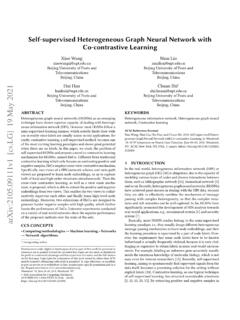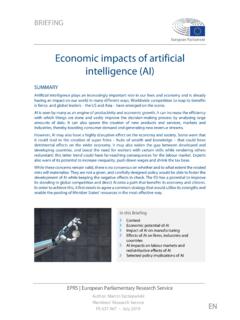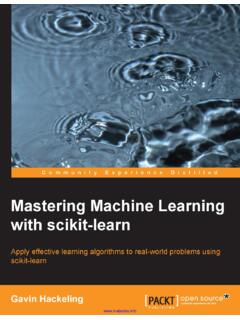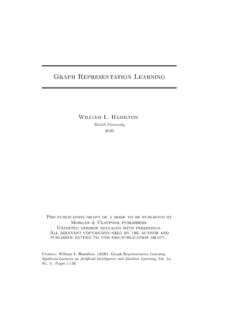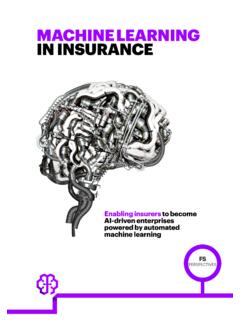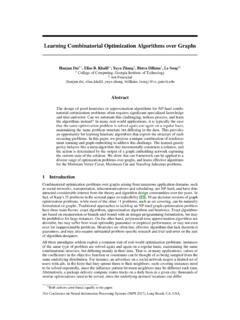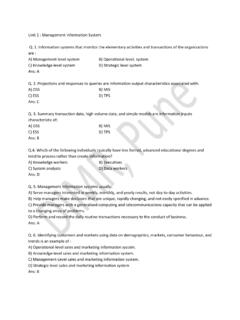Transcription of Applications of Neural Networks in Telecommunications
1 Applications of Neural Networks in TelecommunicationsTrevor ClarksonKing's College LondonStrand, London WC2R 2LS, UKemail: Many researchers today prefer to use the term computational intelligence, to describe techniques such asneural Networks , fuzzy logic and genetic algorithms. These are now seen as complementary rather than competingmethods. A number of current Applications of Neural Networks to Telecommunications are summarised below and somehot topics for future research in this area are given. There is still much work to do in increasing the application ofintelligent techniques by industry so that these techniques feature in developed systems. Some proposals for increasingthe application of intelligent techniques to commercial communications systems are cited, based on academic-industrialcollaboration within Europe and supported by EC Networks of Excellence, which aim to bring this technology : Neural Networks , Telecommunications , training, pattern recognition, controlCLASSIFICATION OF INTELLIGENT SYSTEMSI ntelligence is defined as the capacity for understanding or the ability to perceive and comprehend meaning.
2 As such,numerous researchers are attempting to develop intelligent systems and intelligent methods to solve complex word intelligence can mean news or information. An alternative use of the term intelligent describes a system ormethod able to modify its action in the light of ongoing events. Such systems are adaptive and give the appearance ofbeing intelligent as they change their behaviour without the intervention of a two legitimate uses of the term intelligent are important as they describe systems in common use. The first usageincludes all rule-based methods such as artificial intelligence, fuzzy logic and genetic algorithms. The second usagecomprises techniques such as Neural Networks which aim to perceive and comprehend the significance of the data withwhich they are trained. Neural Networks are best distinguished from other intelligent techniques in that they are nonrule-based and can additionally be made stochastic so that the same action does not necessarily take place each time forthe same input.
3 A stochastic behaviour allows a Neural network to explore its environment more fully and potentiallyto arrive at a better solution than linear methods might partition of systems into rule-based and non-rule-based categories is necessary in order to understand how thesesystems work and where they may be applied. It is often easier to gain acceptance for the first type rather than thesecond. The reasons are fairly clear; it is normally possible to gain an understanding of how the rule-based intelligentsystem arrives at its solution and this can be used to verify that this system will operate within certain an artifical Neural network (ANN) system, it is harder to extract meaning from the values of the neuron weightsand the connections between neurons especially as, under training, these systems often find different solutions insuccessive the data presented to the intelligent system will normally be pre-processed and sometimes post-processed,intelligent systems are often hybrid in nature.
4 In many cases, the intelligent part of the system is evident only duringparameter selection, for example. In a similar way, a hybrid system might comprise a fuzzy logic controller, whosemembership functions are selected by an ANN. Describing such systems as intelligent allows the designer to avoidbeing explicit about the techniques used and the proportion of their INTELLIGENT SYSTEMSI ntelligent systems require training or expert knowledge. Before AI and ANN techniques are developed, a large amountof training data is required either to build the database or to train the network respectively. This training data is oftenhard to obtain and may not be a good representation of the total data set. Using AI, success is often achieved in theearly stages of building the rules and this encourages the user to further develop the ANNs in particular, some experience in the art of constructing and training a network is required before anysuccess is likely.
5 Where ANNs are sold as a black box through which data is passed, new users are often disappointedby the results and ANNs are rejected as a result. Experience in the modes of failure during the training of ANNs isnecessary in order to redesign the this implies a certain level of expertise and in many cases means that each ANN solution is unique, industry is notprepared to spend the time in acquiring this expertise for just one task, which may be only a small part of the overallproject. Data is normally pre-processed or parameterised before being presented to an ANN. There is an art inchoosing the best method, since if an inappropriate method is chosen, the network 's weights might not converge at allduring training. This is the antithesis of industry's needs. If ANNs cannot be delivered as a turn-key package, then theeffort required to implement them may be too , in an intelligent system, where a priori information exists, it should be used either in a preprocessing stage or toaddress the problem using conventional methods.
6 There is no value in forcing the intelligent system to learn what isalready AREAS OF ARTIFICIAL Neural NETWORKSThe following features have been advanced for artificial Neural Networks by Dorffner (1999) as part of a joint Networksof Excellence activity in the development of a technological roadmap:StrengthsApplication areasAbility to solve data-intensive problemsWhere a conventional process is not suitable orcannot easily be defined or cannot fully capturethe complexity in the data,Rapid prototypingAdaptation and learningwhere stochastic behaviour is important,Scalabilitywhere an explanation of the network 's decision isnot 1: Features of artificial Neural networksTypical problems addressed by Neural Networks include pattern recognition, signal processing, time series processing,unsupervised clustering, visualization of complex data, data compression, control problems and image each of the above areas, there is a wide range of current Applications .
7 For example in the pattern recognitionfield, sub-topics include image processing and security Applications , fingerprint recognition, signature verification,secure entry systems and intelligent alarms. It can be seen that these do not operate on the the communicationschannel or control a network , but are added-value services to provide superior user interfaces or additional other examples of existing Neural network pattern-recognition Applications in Telecommunications are shown inTable Structure Interpretation & Text Recognition for Conversion of TelephoneCompany Tabular DrawingsArabic Character Recognition SystemReal-Time Identification of Language from Raw Speech WaveformsTemporal Difference Learning Applied to Continuous Speech RecognitionKeyword Search in Handwritten DocumentsFace RecognitionSelf-organizing Finite State Vector Quantization for Image CodingTable 2.
8 High-level applicationsSome specific current and past Telecommunications Applications for artificial Neural Networks are listed in Table VLSI Neural network Processors for Equalization of DigitalCommunication ChannelsAdaptive EqualizationChannel Equalization by Distribution LearningEqualisation of Rapidly Time-Varying Channels Using an Efficient RBF NeuralNetworkEqualization and Fast Adaptive Signal Recovery in Very Heavy Tailed NoiseNeural Receiver Structures Based on Self-Organizing Maps in NonlinearMultipath ChannelsNetworkDesign,Management,Routing andControlAdaptive Routing in Very Large Communication NetworksA Distributed Reinforcement Leaning Scheme for network RoutingA Learning Model for Adaptive network RoutingOptimal Traffic Routing Using the Self-organization PrincipleHopfield Optimization Techniques Applied to Routing in Computer NetworksScheduling Problems in Radio Networks Using Hopfield NetworksNew Q-Routing Approaches to Adaptive Traffic ControlDynamic Routing in ATM Networks with Effective Bandwidth EstimationIntelligent Capacity Evaluation/Planning with Clustering AlgorithmsNeural Networks for network Topological DesignLocation Prediction in Mobile NetworksATM networkcontrolATM Call Control by Neural NetworksA Hybrid Admission Control Scheme for Broadband ATM TrafficATM Multimedia Traffic PredictionConstrained
9 Optimization for SwitchingATM Cell Scheduling for Broadband Switching SystemsTraffic Trends AnalysisControl of Self-Similar ATM Call Traffic by Reinforcement LearningHardware Implementation of Reinforcement Learning for Call Admission Controlin Networks for Integrated ServicesGeneration of ATM Video TrafficATM Traffic Policing using a Classifier SystemComputing Blocking Probabilities in ATM Virtual SubnetworksFaultmanagementIdentifying Fault-prone Software ModulesLearning Index Rules and Adaptation Functions for a Communications NetworkFault Resolution SystemUsing Distributed Neural Networks to Identify Faults in Switching SystemsPre-processor for a Fault Diagnosis Expert SystemNetworkMonitoringPrediction of Access Line GrowthTechniques for Telecommunications Fraud ManagementLearning Customer Profiles to Generate Cash over the InternetTable 3: Selected artificial Neural network Applications in communicationsHOT TOPICS IN COMMUNICATIONSThe IEEE Communications Society is active in developing a list of state-of-the-art topics in communications.
10 Some ofthese are areas in which Neural Networks have a r le, such as signal processing for beamforming, adaptive antennas,consumer communications, radio resource management and mobility management. This list will be developed anddisplayed on the Communications Society web page in the future (Kartalopoulos, 1999).Beamforming employs signal processing in transmitting information over multiple antennas. It is also used forreceivers to create steerable arrays. The purpose of beamforming is to minimize interference whether this be caused byfading, reflections or the effects of multi-user interference. If the channel is unknown or is changing, an adaptiveantenna system will prove to be an advantage. Adaptive antennas can also offer capacity enhancements or allow higherbit-rates to be products will soon have the capability of high-speed communications.
